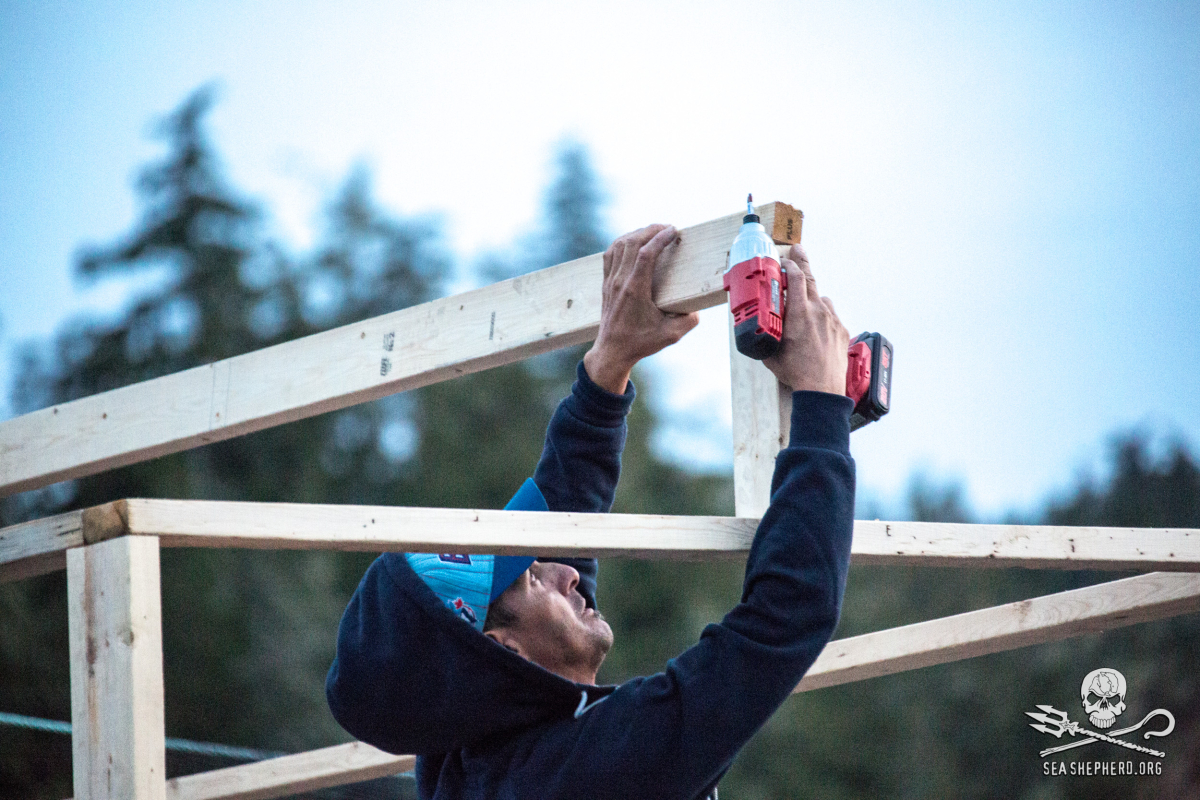The fight to protect wild salmon
As soon as you step off the ferry at Alert Bay, it's hard to miss. You're greeted by a sign that reads “Namgis First Nation, Welcome.”
The Sisiutl, a mythological creature, is painted on a wooden arch stretched over the top. Sisiutl depicts good on one side and evil on the other, with the truth centred in the middle, community members explain.
And right below that is a colourful banner that shouts: “Protect wild salmon. STOP open net fish farming.”
The latter is a message left by youth in the community.
The story of salmon, the jewel of B.C.'s Broughton Archipelago, has turned into one of science, human rights, Indigenous sovereignty and ecological justice. It's also a heaping load for the provincial New Democratic government to contend with — just weeks into its brand new mandate.
Emilee Gilpin reports.
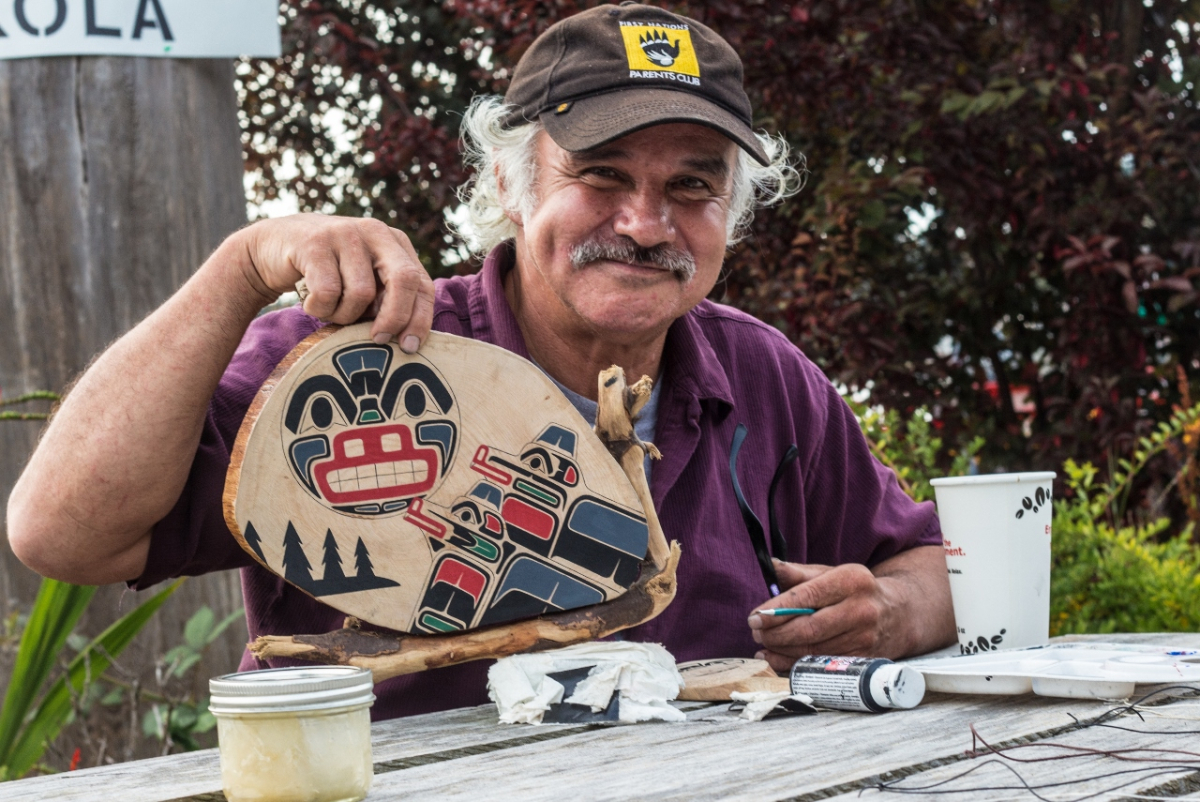
Most days, Gordon Mellish sits ten steps from the sign, facing the road. Mellish, a man who used up his nine lives on the ocean, now paints, crafts jewelry and shares stories with those lucky enough to sit down and listen.
It’s not just the fish farms that are the problem here, Mellish says, which have surely impacted the health of the ocean and the soil. It’s the mismanagement of the logging camps, too, and the fact that no one listened to Indigenous peoples who had advanced systems of managing coastal resources.
“We were very Indi-genius,” he laughs. He points to the mountains and valleys just across the water from the docks. He has seen the valley get clear cut three times in his lifetime and the harmful impacts on the environment.
Mellish explains that Alert Bay, a village on Cormorant Island, northeast of Vancouver Island, used to have the best water in British Columbia, but now, because their water run is infected by the soil from logging camps in some places, they have to boil it.
“It’s the farms, it’s the logging, it’s the mismanagement,” Mellish says.
The occupation
Hereditary Chief Ernest Alfred, from the ‘Namgis, Lawit’sis and Mamalilikala Nations says enough is enough.
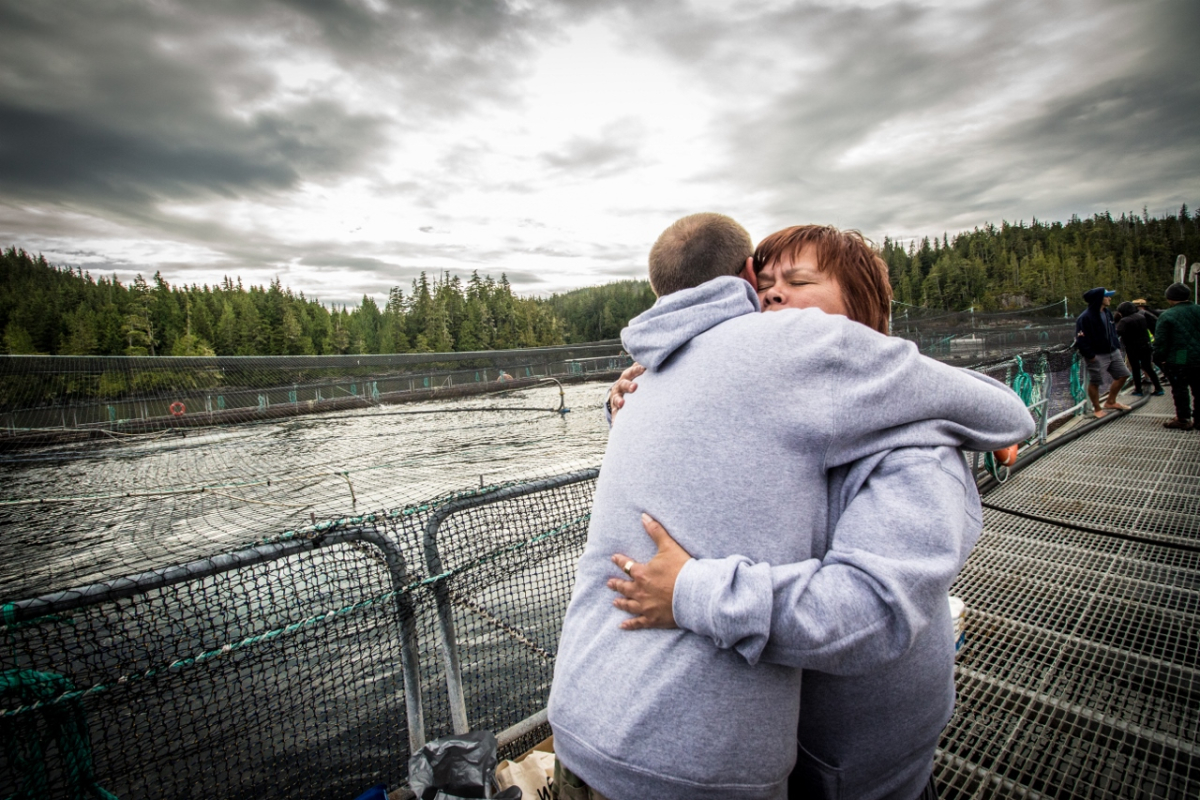
The occupation of the Marine Harvest farm on Swanson Island is the latest of many coastal First Nations’ actions to protect the wild salmon whose traditional migration paths cross through one third of B.C. Salmon Farm’s fish farms, situated along the east coast of Vancouver Island.
The cause brings together scientists like Alexandra Morton (who raised her children in the area), the Sea Shepherd Conservation Society, hereditary chiefs of many coastal nations, and environmentalists to speak for the species that keeps the coast alive, the Pacific wild salmon.
On Friday, Aug. 25, Alfred was joined by hereditary chiefs of neighbouring nations, in a show of support. The visits have not stopped since.Everyday, people make a trip from their separate points of departure, in some cases spending a few hundred dollars for water taxis, bringing food and supplies from supporters back home.
The Musgamagw Dzawada’enuxw Nation, divided into four communities, all descend from the Kingcome Inlet, one of the lesser fjords of the British Columbia coast.
The Nation has been fighting illegal fish farms since they first arrived on their territories 31 years ago. Alfred and Chief George Quocksister Jr. say that rightful community representatives never agreed to the farms and have deferred every government referral that has sought consultation on the matter in the past.
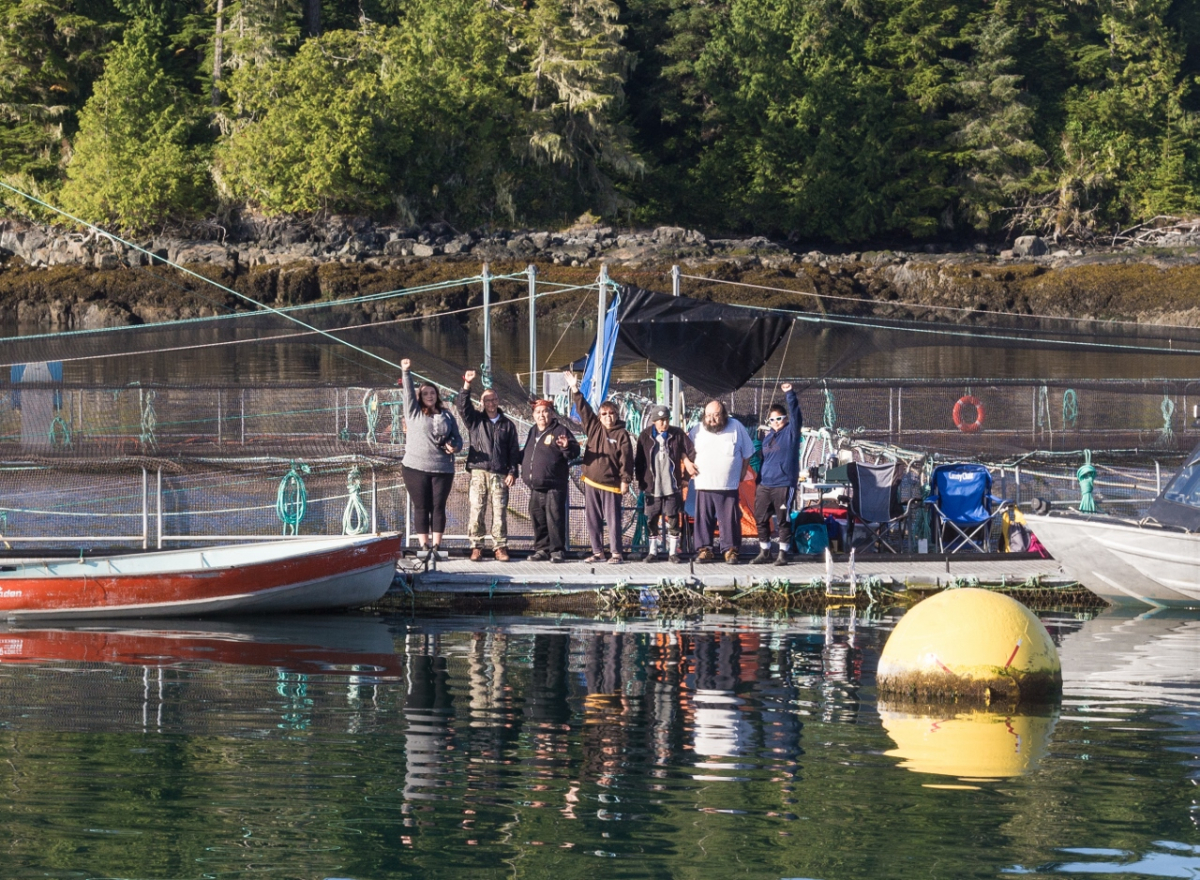
Resistance is not new to these territories
Those at the frontlines today are part of a long line of colonial disobedience, tracing back even before their ancestors tricked the Archbishop of the Anglican Church into raising a pole in honour of King George. Really, members of the community say, they were breaking the potlatch ban that suffocated their culture.
They were showing the world they stood strong and defiant.
But after news of the catastrophic salmon spill near Cypress Island earlier this month, of thousands of farmed Atlantic salmon escaping after their net pen ripped open from rough tides, the stakes are higher.
Members of the Musgamagw Dzawada’enuxw Nation are also joined by scientist Alexandra Morton and Sea Shepherd’s primary research vessel, a team that drew attention after releasing groundbreaking footage of illegal bycatch and serving eviction notices to Marine Harvest last year in a mission they call Operation Virus Hunter.
Bycatch refers to the baby wild salmon, perch or herring that get caught in the farm’s pens. These trapped wild fish are either eaten by the farmed salmon, contract diseases, or eat the artificial feed and experience abnormal mutations. This illegal practice is one of the crew’s strongest claims against fish farms along wild salmon migratory routes.
Marine Harvest Canada says deformities are rare
Ian Roberts, a spokesman for Marine Harvest Canada, says no images indicate or prove disease. He adds that deformities are very rare in salmon, but like other animals and humans, they can occur.
"We are able to remove any poor performing or deformed fish from our farms before they are sent to market," he says. "Our salmon are very healthy, are regularly checked for health by licensed veterinarians and audited by Fisheries and Oceans Canada."
He says the company has regularly invited the 'Namgis First Nation and its members to visit and observe its operations, but to date they had declined to visit or meet.
"While this unscheduled visit was a surprise to us, we have allowed them to remain on site to observe our operations as long as they remain respectful and peaceful, and not harass our staff or harm our fish," he says.
"To date, they have remained relatively peaceful, but we are growing increasingly concerned about the health and welfare of the individuals. ... We have again contacted the nation's elected representative to meet and discuss their concerns."

Roberts confirmed the company does not have a formal agreement with the 'Namgis, but he said the company has provided juvenile fish to the First Nation in the past for its land-based salmon farm, Kuterra.
Chief Quocksister Jr. has dismissed the company's statements.
“They’re running a herring fishery, I don’t care what they say,” Chief Quocksister Jr. says.
The industry
In what is known as the Broughton Archipelago, everyone has something to say about salmon.
As Alfred begins his occupation of the Marine Harvest farm, fish farmers — including a handful of First Nations workers — finish their day's work, and they have a smoke.
They gather around the ferry stop in Port McNeill, headed to Alert Bay, with dirty boots and pants and bodies that are ready for rest.
They discuss how many years each has been working on a farm, some bragging of ten-plus years with the same company. But they quickly switch to talk of UFC. For after a long day, there’s nothing like a cold beer and somebody else’s fight to leave the work behind.
The men at Port McNeill have seen the news, especially the more recent farmed salmon spill, and they admit that the news doesn’t look good on fish farms. But the companies have stepped up safety regulations over the years, they say.
And, one worker who wishes to remain anonymous says, “Fish farms will never go away, there’s too many dollars involved.”
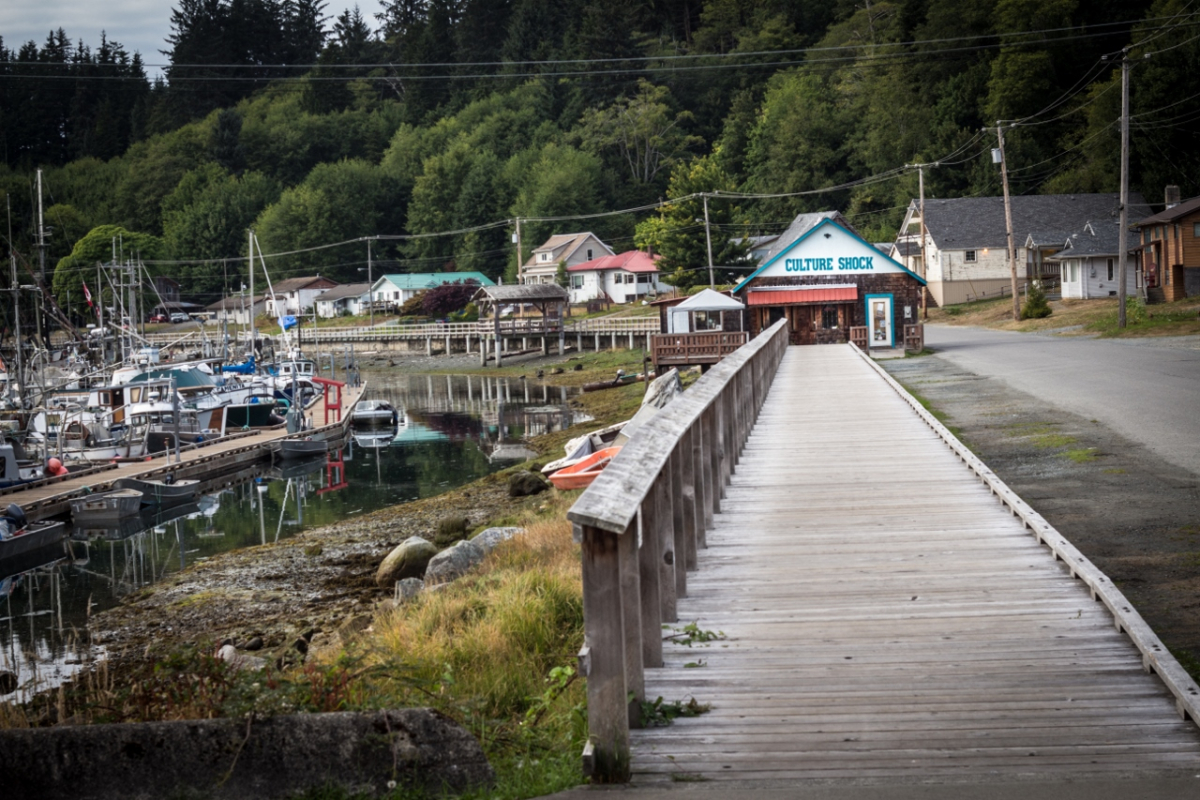
The men arrive at Alert Bay and disperse to their homes or favourite watering hole. Two minutes down the road from the main government dock sits Bayside Inn, a simple restaurant and hotel, with shutters drawn.
As soon as the door is unlocked at 8 a.m. on Saturday, a group of men pile in, ready for a cup of steaming coffee, a plate of pancakes or eggs, and a healthy serving of local gossip.
The group has heard about Alfred’s occupation on the fish farm and while some keep quiet, worn out after years of discussing “the same damn thing” — as one person puts it — others have some fight left.
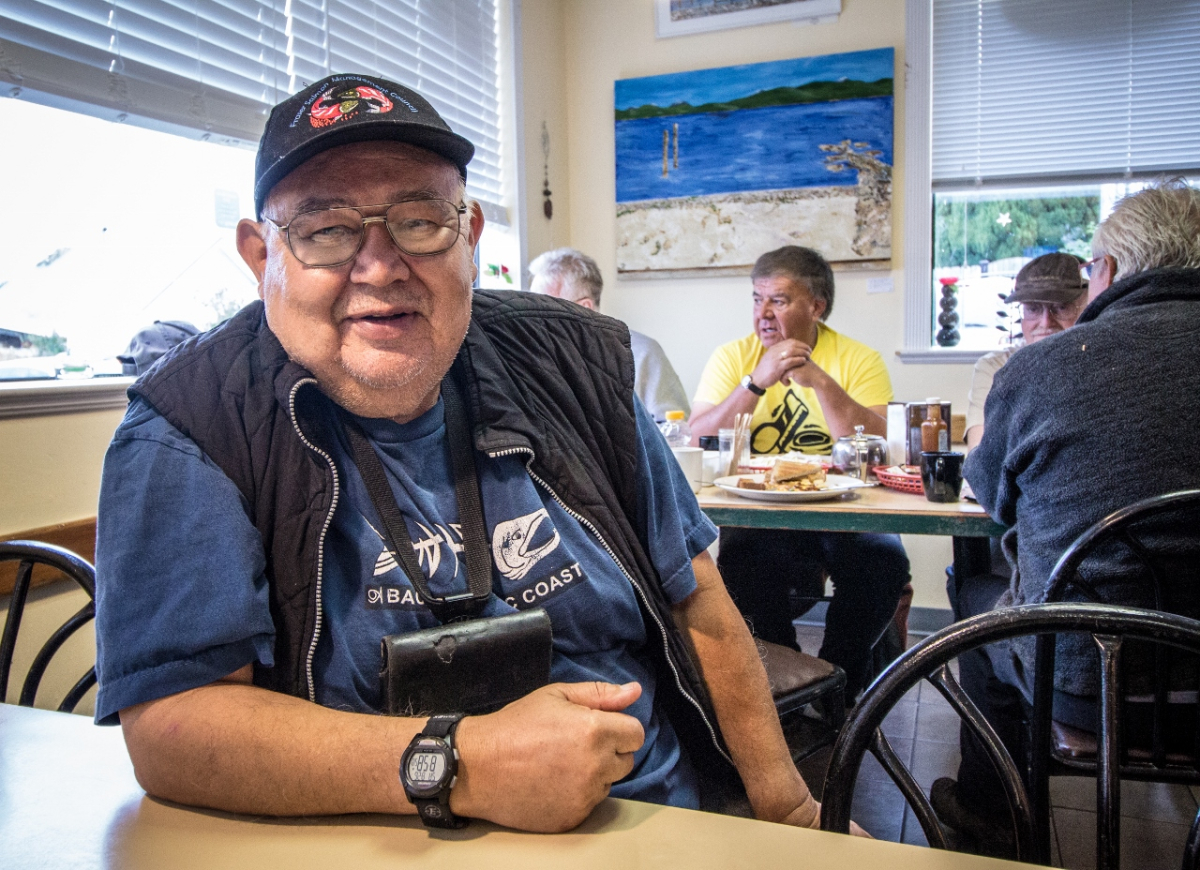
Arthur Dick, 68, and a lifelong resident of Alert Bay, says if you’ve heard anything about him, it’s all true.
Dick can’t wrap his head around the logic of disrupting or destroying the natural world, “I can’t think like them if I tried,” he says.
Maybe the folks that are running these businesses run more on diesel batteries than heart, he jokes, adding that he’s not afraid to speak the truth, even when it pushes people away.
Dick used to work on a fish farm for the IBEC corporation back in the 1980s, and he says he remembers how they were managed and all of the sewage they produced. He remembers mussels that clung to the nets and how, when they got so bad and so thick, the farmers were instructed to drop them down deep enough that they couldn’t survive. These practices turned him away from the industry, which didn’t respect the wildlife, he says.
Dick was fired, he says, after IBEC was sold out to Stolt in the 1980s and he never went back to the industry.
When he saw how bad things had gotten, in the video footage released by Chief George Quocksister Jr., he cried. The footage, taken at various fish farms situated on the traditional territory of the wild salmon, woke Dick up to the urgency of the issue.
He made the trip out to see Alfred on Sunday and says he supports his community’s demand for governmental action.
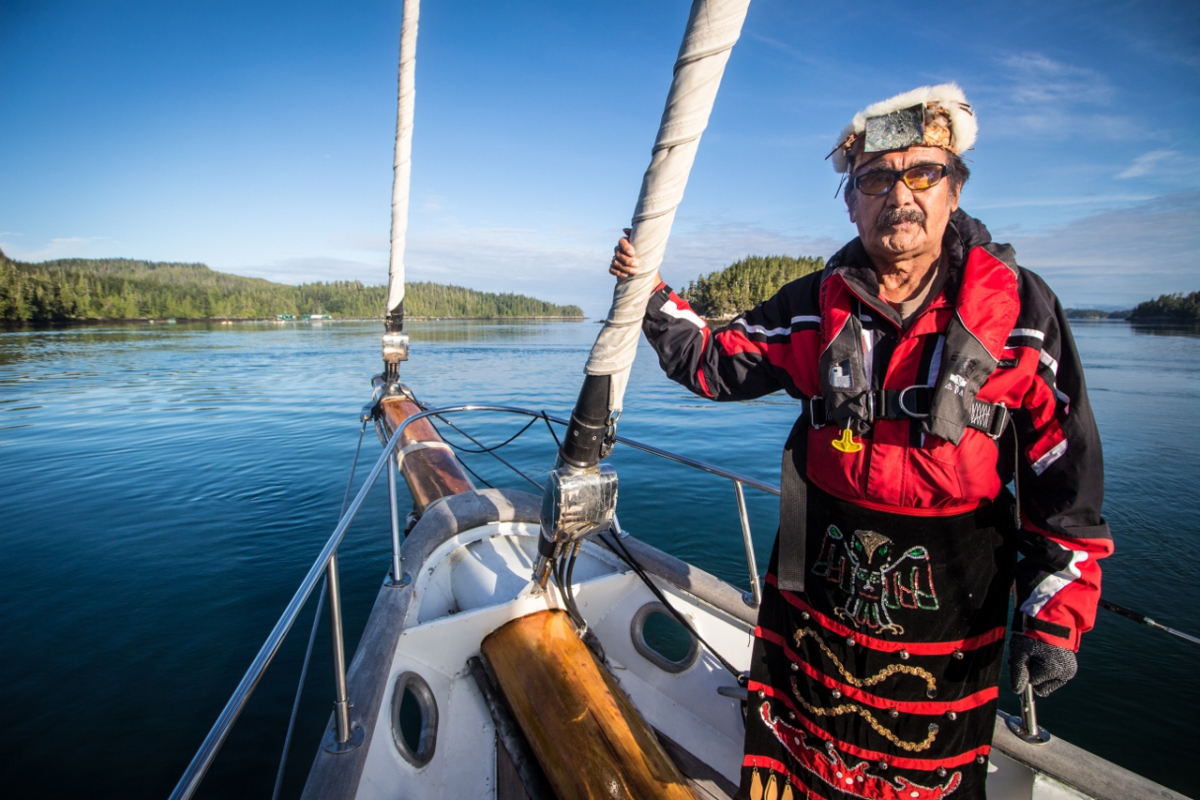
The alternatives
In Alert Bay, B.C., some want to talk about solutions rather than focus on the negatives of fish farming.
Some of Dick’s friends, like Billy Wasden, are tired of talking about the problems, which they know too well, having lived their entire lives in the area.
Wasden, also on the ‘Namgis tribal council, will scold even a stranger for not wearing a smile. He’s more interested in talking about solutions than conflict.
“Look at Kuterra and go visit it,” he says, choosing to focus on a preferable option, or any alternative with no harm to the environment. Kuterra is a land-raised salmon farm on northern Vancouver Island that prides itself on not using antibiotics or having contact with the marine environment.
It is the first of its kind, and doing well, Wasden says.
But if you talk about land-based fish farms to Chief George Quocksister Jr., hereditary chief from the Laich-Kwil-Rach and primary mischief-maker on the Sea Shepherd research vessel, the Martin Sheen, he’ll shake his head at you.
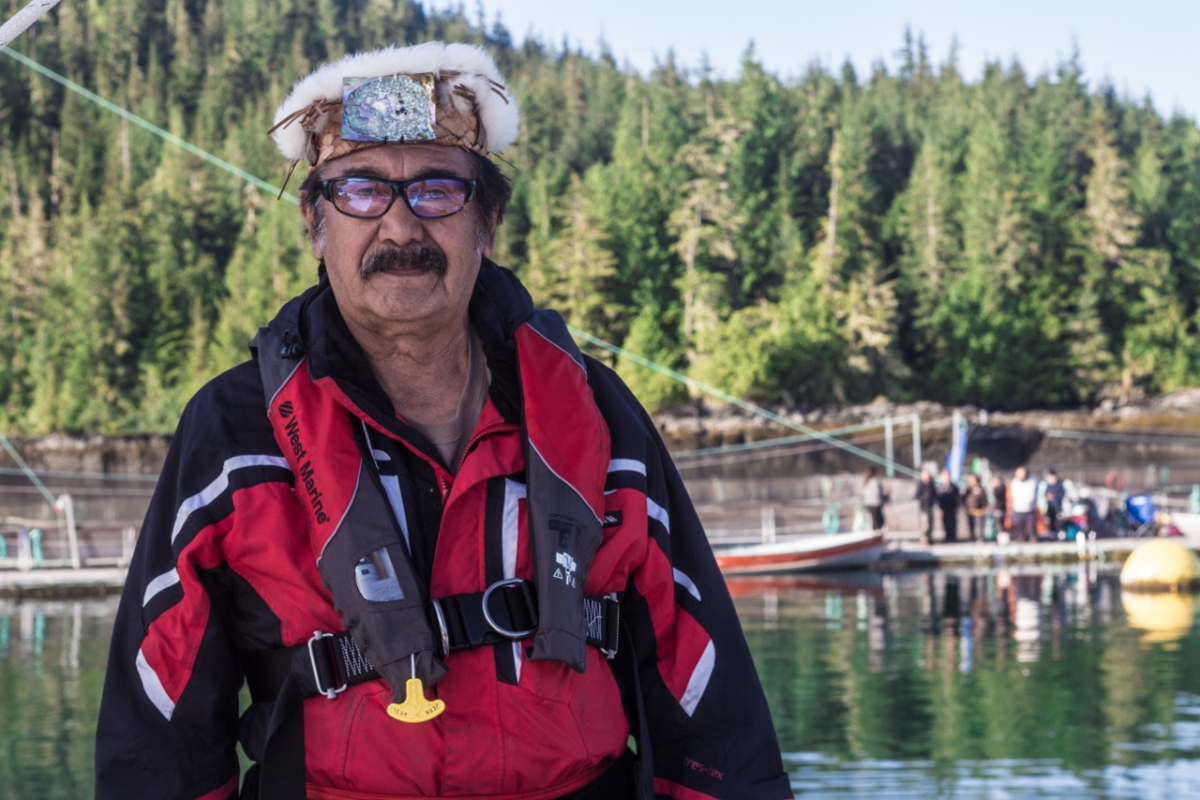
“People say put them on land, but I say get them the hell out of this country,” he says flatly. His sudden serious tone is unusual for someone who has been the source of laughter for crew members. Together, they have spent the past months hard at work, supporting the First Nations’ land defence, conducting studies, and trying to report with little access to the internet.
Quocksister Jr. says First Nations have the “know-how” to manage fisheries that aren’t destructive to the environment, like his community had done before the commercial industry took over.
Wearing yellow tinted sunglasses and a glove on his left hand, which is missing half a finger, Quocksister Jr. often lightens the mood by teasing the crew about underwater octopus monsters. He says he lost half a finger from a shark attack. Then he bursts into laughter, winks, but never gets around to sharing the real story.
Sometimes, it’s better to keep your cards close to you.
For Quocksister Jr., it’s the illegal bycatch of baby wild stock that he found in the pens that the government needs to respond to.
He knew it was there, he says, but the proof makes it impossible to deny. Quocksister has requested photos from fish farmers over the years, and he’s more than willing to share what some anonymous workers sent him — photos of baby perch and herring, whatever fish is in season he says, trapped in the pens.
Not everyone is opposed
Elected chief John Smith grew up with Quocksister Jr., though they’ve lost contact over the years. He agrees that land-based fish farms are not the solution and says that if they were successful, they’d be right beside the markets, not out on the water.
But Smith is a fish farm supporter.
If he thought the farms were a threat to his territory, he says, he’d be one of the first to speak up. He adds the benefits — like the economic gains — outweigh the negative impacts. Smith says he’s eaten lots of the farmed salmon and he’s “still very much alive.”
Smith isn’t happy about the occupation and doesn’t want anybody snooping around his farms uninvited, though he’s happy to arrange planned visits, following appropriate protocol. He doesn’t think the fish farms are a big issue, and claims a 90-per-cent survival rate of healthy farmed salmon.
Maurice Isaac, better known as Moe, could be a ‘Namgis band member, but he’s a Tlowitsis member through his mother’s side.
Isaac lives in Alert Bay and has been working in the fish farm industry for 17 years. For the last eight, he has worked for Marine Harvest and now manages the Midsummer Island facility on Turner Island.
Isaac comes recommended by Marine Harvest as an important voice in the conversation about fish farming.
Isaac grew up as a wild salmon guy. His grandfather was more traditional, he says, and even when he saw the commercial industry start to grow excessively, he insisted on catching only what could be eaten.
“But everything was changing, everything was getting bigger,” Isaac says, and he and his uncles wanted to be a part of that growth.
Isaac has a hard time with the way that fish farmers are painted in this whole debate, he says, since they’re really just guys trying to make a living, play their part and feed their families.
Though it took him a few years to get accustomed to the taste of farmed salmon, and wild salmon will always be his first choice, he says he trusts his industry’s regulations.
He respects the way Marine Harvest follows procedures and measures to deal with the baby by-catch, sick fish and environmental impacts. His says the company vaccinates the fish when necessary and deals with any viruses or outbreaks right away.
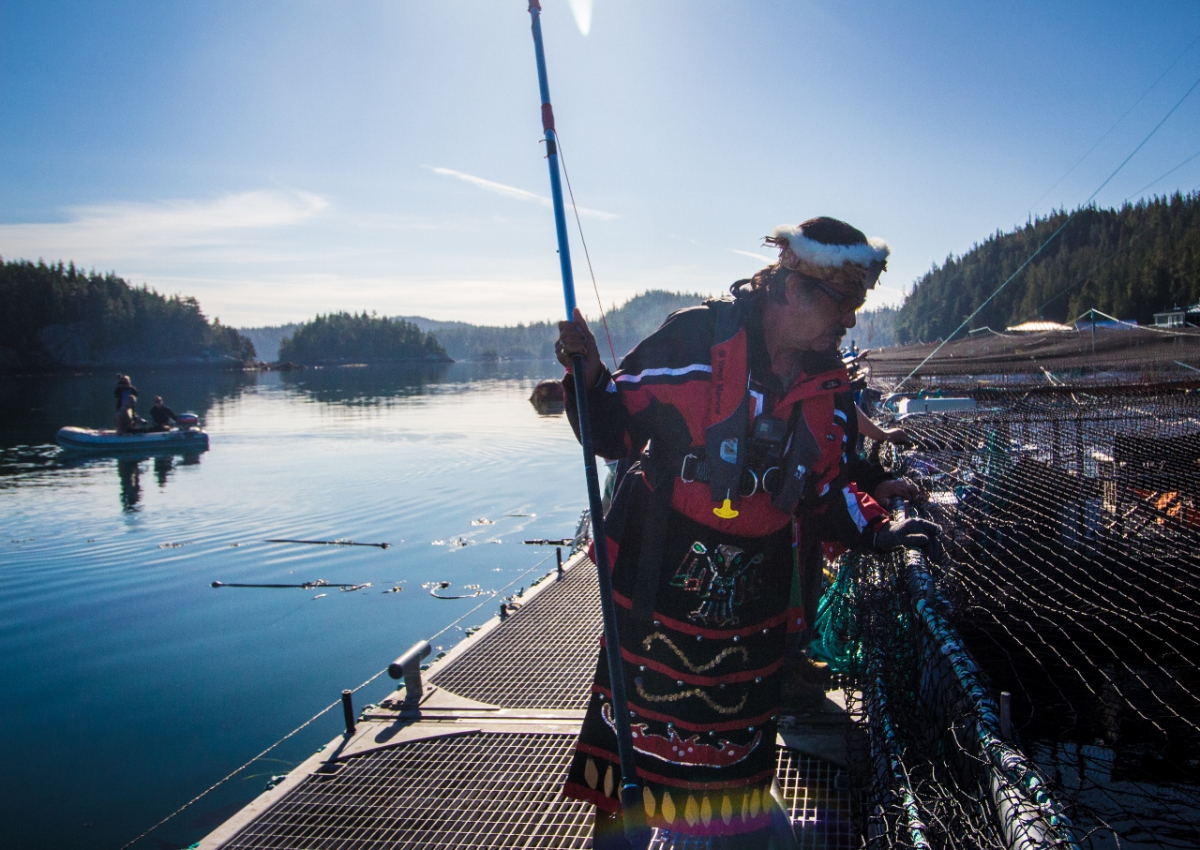
“You gotta be blind not to see what’s in those pens,” Quocksister Jr. retorts.
And indeed, some of the salmon floating in the Marine Harvest farm on Swanson Island are reported to be blind and sick, floating aimlessly about with pieces of red flesh visible.
Both Quocksister and Smith say the dead or sickest salmon are removed from the pens and destroyed, taken away by what they call “mort totes” that trail a deadly stench in their wake.
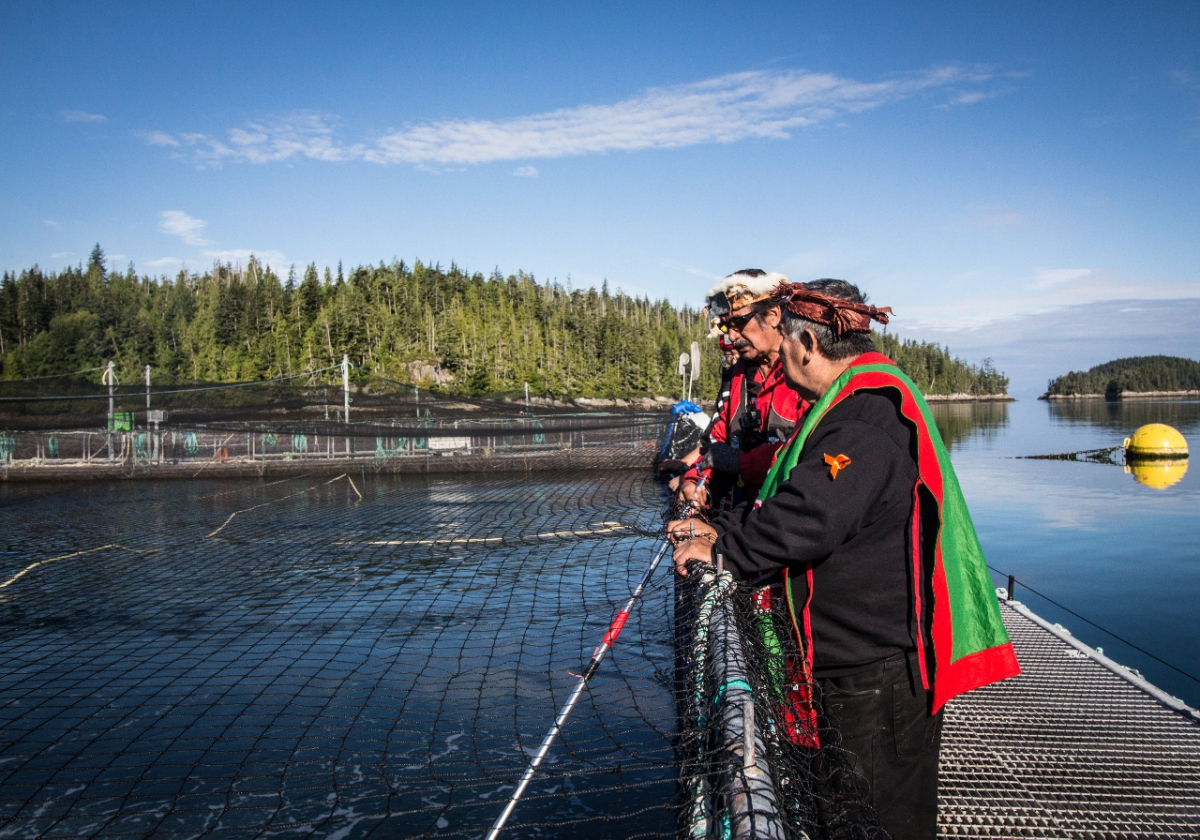
The science
For scientist Alexandra Morton, those with the political power to legislate fish farms out of the ocean are not blind, but they intentionally avoid the cause, for reasons she cannot fathom.
Just look at Norway, Scotland, Ireland and Eastern Canada she says, where wild salmon and sea trout go into decline everywhere fish farming exists.
“If you go north to Alaska, fish are doing great and they've got four times as many sockeye as they forecast,” she says, standing on the side of the Martin Sheen, taking a brief moment away from her computer and notes.
“Look at Russia and the good returns they’re getting. These fish are all going to the same ocean to feed, yet it’s only in B.C. where they’re crashing.”
Morton grew up in Connecticut, but moved to the area in 1984 to study killer whales. At first, she was on friendly terms with Fisheries and Oceans Canada, formerly the Department of Fisheries and Oceans (DFO). Looking back, she laughs dryly at her naive self and wishes she could hug her and tell her she was in it for the long and hard run.
Morton used to update the federal department when she saw the harmful impacts of fish farms on the surrounding ecosystem. She saw how the seal scarers displaced whales, how the Atlantic salmon showed up in the rivers and hatchery, and she wrote letters to the federal government informing them of this. She says it was a job that kept the post office in business.
She was told every time, “Dear Miss Morton, there’s no evidence,” a phrase that haunts her to this day. They were trying to get her off the case, she says.
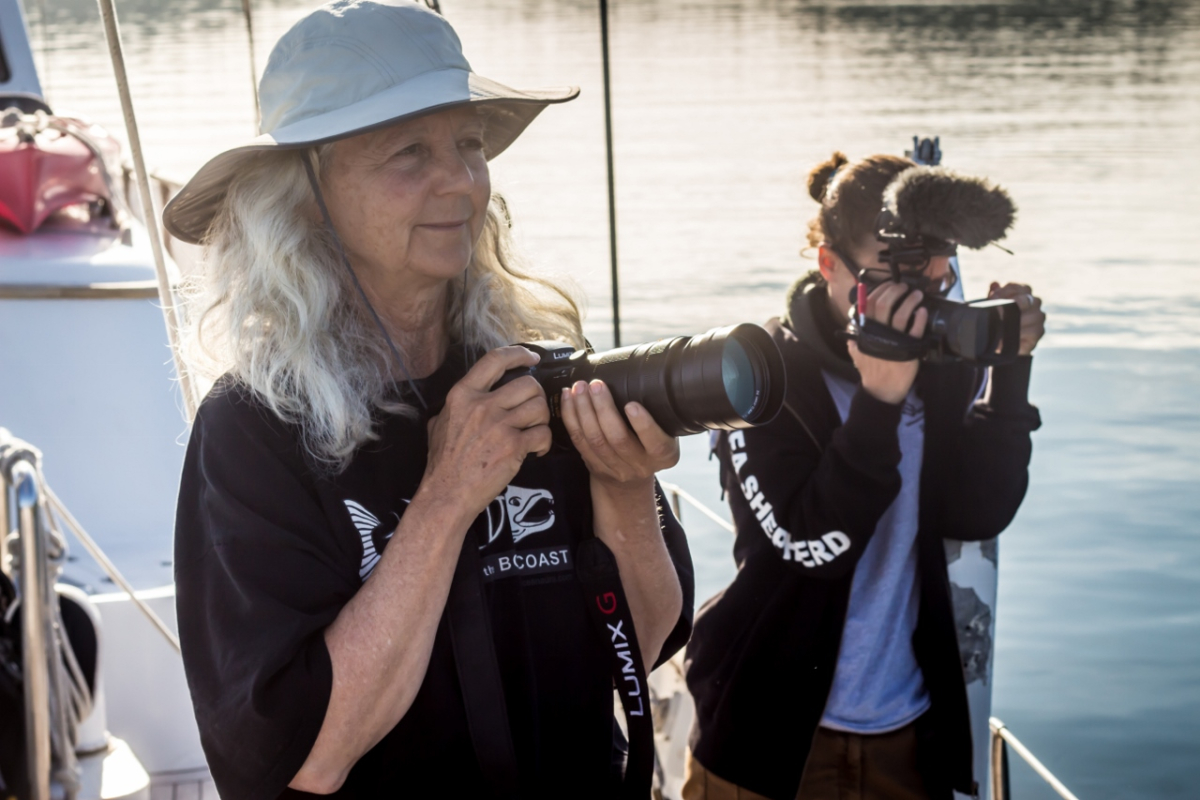
As the biologist on scene, she decided to provide the evidence. After publishing on the displacement of killer whales, which is illegal in Canada, she researched what happens to Atlantic Salmon when they escape. Then she got to sea lice, a study she has been conducting for 17 years.
“I thought if I provided DFO with the science, that would be enough … but it wasn’t,” she explains, a strain in her throat, retelling a story she has now told too many times.
Other factors may have contributed to the decline of commercial fishing in the Broughton Archipelago, but Morton places much of the blame on farmed fisheries.
“The commercial fishing collapsed, the salmon stopped coming in, the First Nations couldn’t get food fish," she says.
Learning to listen again to the wild salmon
Morton had no choice but to take the path she had avoided for years: that of an activist.
But she has also searched for evidence of disease in the fish. And over the years, she has tested samples of salmon from supermarkets and sushi restaurants, noting that she hasn't been given access to do this kind of testing for the fish directly on the farms.
A lot of the salmon have tested positive for Piscine Reovirus, which scientists found had come from Norway.
She is currently in court with the federal fisheries department, trying to prevent the release of Atlantic salmon, infected with piscine reovirus, into the waters.
What is so frustrating, she says, is that there is actually a beautiful solution available: Canada should be talking to the industry about closed containment, or farming systems that prevent contact with the natural environment, and finding out what they need.
Morton dreams of a provincial department of wild salmon and a Vancouver that embraces the fact that the biggest salmon run goes right through the city. She dreams of all of the First Nations in the area, universities, scientists and stream-cleaners getting together to sample the fish and doing genomic profiling, in order to listen to them again.
“We could just use what they say to guide our behaviour and strategically get out of their way,” she says.
“Buried in the DFO is this remarkable scientist Kristi Miller,” she says. “She can read the immune system of fish, so they can talk to us again like the First Nations legends speak of. The information recorded in immune systems is so detailed, you could see the problem and go back with area-based solutions.”
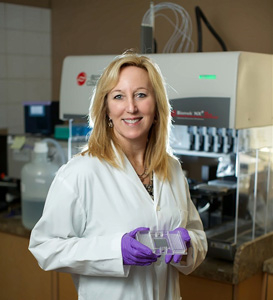
Miller, a Fisheries and Oceans Canada scientist whose research was once silenced under the Harper government, carries out scientific research on the role of disease in wild salmon declines. Her department recently published a paper about using the activity of host genes to identify the difference between a fish that carries a virus and a fish that’s diseased by a virus — without killing the fish, she says over the phone.
Miller says this research is a great step, but that there hasn’t been enough concentrated effort in Canada to identify the real risks of farmed salmon. She says Morton has done a lot to get the ball rolling, but that more empirical data is needed, to do a meaningful risk assessment.
In order to accomplish this goal, Miller wants to see all parties involved communicating, working together and looking at the facts available objectively.
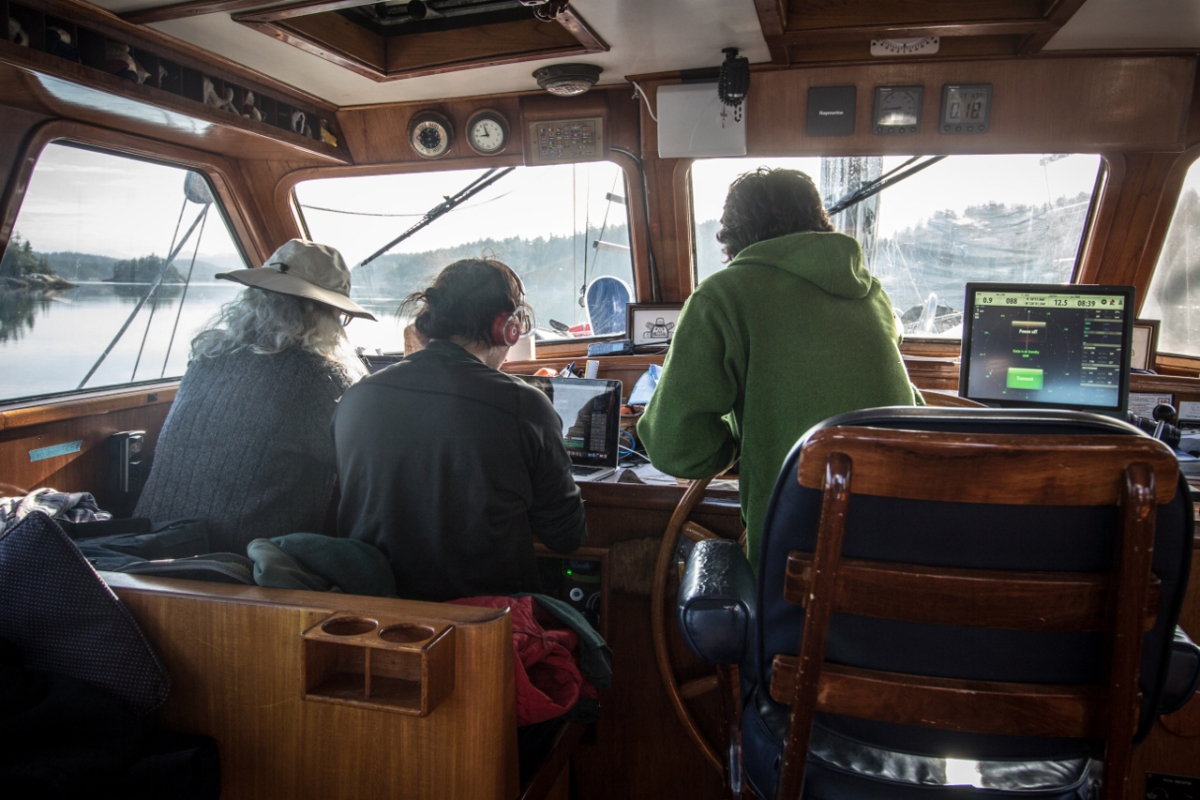
Carolina Castro, a member of Sea Shepherd Conservation Society for 16 years, is the campaign leader for the wild salmon mission, now named Operation Virus Hunter II. She says that when Paul Watson, the founder of the society, caught wind of Morton’s research and pushback, he sent their primary research vessel in support.
“The campaign with Alexandra Morton started as a research project,” Castro says. “The information that came out is groundbreaking. This footage reveals that most of the farms have a lot of diseased-looking fish, but we’re not allowed to test them. Now the campaign took a turn and we’re supporting the First Nations to take back their territories.”
Castro says that Sea Shepherd is prepared to support the First Nations communities making a stand. “We are honoured to join them in their fight,” she says.
The challenge for B.C.'s new government
While the industry responds to its critics, defenders of wild salmon say the issue of fish farming is a "litmus test" for the new NDP government.
About five people might work at a fish farm site. Afred says those working at the Marine Harvest farm on Swanson Island during the current occupation are dealing with the First Nations representatives in a friendly manner.
Quocksister likes to point to a sick fish and ask the workers what they think about it, to which they respond, “no comment,” as they have been instructed to do, he says.
The B.C. Salmon Farmers Association, based in Campbell River, B.C., is punctual and respectful as it deals with escalating criticism.
Jeremy Dunn, the association's executive director, says over the phone that the criticisms of the industry are not new. He just got back from Aqua Nor, the world’s largest aquaculture trade show, in Norway.
He says the industry has evolved over the years and that farms are operating in ways that are respectful of the environment. They now follow specific guidelines such as the requirements for Aquaculture Stewardship Council certification. These are based on environmental standards recommended out by the World Wildlife Fund.
Companies are increasingly transparent, Dunn says, and anyone is welcome to schedule a tour of a farm and be guided through.

But, Morton asks, if there truly is transparency, why isn’t she allowed to sample the farmed fish?
And, she asks, why won’t anyone respond to her request for a public debate, which could include, “Me and however many of you (that) you want.”
Asked about the salmon spill near Cypress Island in Washington State in August, Dunn says it’s not his jurisdiction so he really can’t comment.
After news of the salmon spill made international headlines, the industry found itself tackling questions about whether it needed to pay more attention to rougher waters that appear to have played a role in the incident. The rougher waters are consistent with climate change projections, and fish farm critics worry that diseased farmed salmon will continue to enter open oceans and negatively affect wild species.
But rougher waters aren’t bad, Dunn says. He explains that these rougher waters also mean higher oxygen levels and healthier fish, a point that fish farm workers echo.
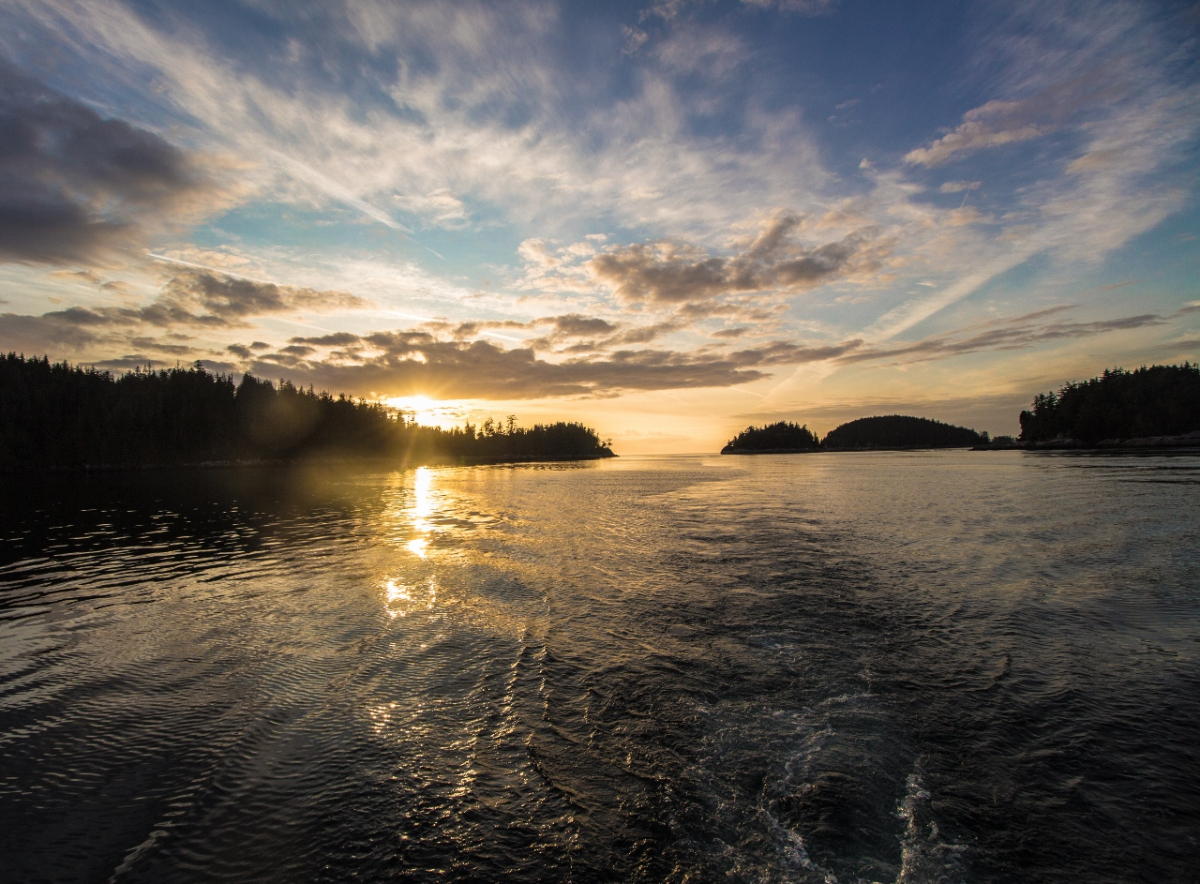
What can the provincial government do?
When asked about escalating tension in Swanson Island, Andrew Weaver — whose Green Party helped put the NDP in government in B.C. earlier this summer — responds by email.
“The B.C. Green caucus remains committed to ending open pen salmon farming along wild salmon migratory routes,” he says.
“The technology is available to shift to land-based closed containment systems that pose no risks to wild salmon stocks. It is encouraging that the B.C. NDP promised to begin this shift in their platform.”
Indeed, in their election platform, the NDP promise to “ensure that the salmon farming industry does not endanger wild salmon by implementing the recommendations of the Cohen Commission, keeping farm sites out of important salmon migration routes, and supporting research and transparent monitoring to minimize the risk of disease transfer from captive to wild fish.”
The B.C. government did not respond to National Observer interview requests through the first week of the Swanson Island occupation.
Meanwhile, the federal government announced on Aug. 31, 2017, that it is seriously concerned about salmon stocks and plans enhanced enforcement of illegal fishing practices along the Fraser and Thompson river systems in the next few days.
Those occupying the fish farm say they aren't moving until things change.
The most recent occupier is 21 year-old Molina Dawson from the Kingcome Inlet. While some describe Dawson as shy, others say she is older and wiser than her years show.
She’s certainly not afraid to speak about why she’s setting up a tent on the Swanson Island fish farm.
“I’m doing this because it’s important. Everything relies on the salmon,” she says, wearing a sweater with the skeleton of a salmon on it and “backbone of the B.C. coast” written across the front.
“Even the trees get fed from the salmon. They die and the bears eat them, then they spread the nutrients they get from the sea.”
“I love this coast,” Dawson adds. “It’s where I’m from, it’s where I’m most at home.”
Tamo Campos, 27, is the grandson of celebrated environmentalist and scientist David Suzuki, but has crafted his own reputation through direct action resisting fossil fuel infrastructure in B.C.
“You can’t talk about reconciliation while at the same time continuing to force an industry on a community that has continued to say no,” Campos says.
Campos has worked as a videographer and blogger for Morton and the Musgamagw Dzawada’enuxw people, and feels honoured to join a fight that stretches back many generations.
“You can’t say this is in the public interest, because science disagrees. So this is the litmus test for this new government,” he says.
The clock is ticking
Hereditary Chief Ernest Alfred agrees the issue is a litmus test for the provincial government.
He has publicly called on NDP Premier John Horgan and Green Party leader Weaver to intervene.
The provincial government needs to stop renewing fish farm licenses, expel the farms from his unceded territory, and play an essential role in cleaning up the ocean and preventing further devastation.
It can’t be about jobs, Alfred says, since there are only a handful of workers per farm and there are way more jobs in the ecotourism industry, which Fisheries and Oceans Canada claims is around 5,000, direct and indirect, but Morton estimates is more like 1,900.
Plus, what jobs will be left in the ecotourism industry that employs around 56,000 people, Morton asks, and what happens to these when everything the wild salmon holds together dies? The bears, the whales, the trees that feed the air we breathe?
Those opposing the fish farms have questions. What keeps the provincial government so loyal to these companies? How will the new B.C. government respond to escalating tension?
Alfred and company continue to receive support from visitors and solidarity protests in cities across the province. Fish farm protestors, or wild salmon protectors, are building a house on the Marine Harvest fish farm at Swanson Island, and there is talk of occupations on neighbouring farms.
And on Aug. 31, the Musgamagw Dzawada’enuxw Nation, led by Hereditary Chief Willie Moon, occupied another Marine Harvest salmon farm, Wicklow Point, in the Broughton Archipelago off northeastern Vancouver Island.
Those standing up to protect the ocean demand answers, and the clock is ticking.
with files from The Canadian Press

